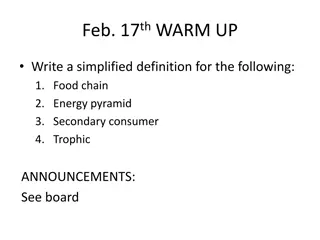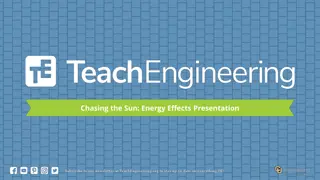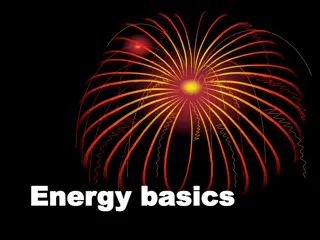Explore Energy in Food and Daily Activities
Discover the relationship between energy in food and daily activities. Compare energy values of different foods, estimate daily energy intake, and analyze energy needs based on physical activities. Explore suitable foods for high energy requirements, and understand how to balance energy expenditure. Engage in interactive tasks and discussions to deepen understanding of energy consumption and utilization.
Download Presentation

Please find below an Image/Link to download the presentation.
The content on the website is provided AS IS for your information and personal use only. It may not be sold, licensed, or shared on other websites without obtaining consent from the author. Download presentation by click this link. If you encounter any issues during the download, it is possible that the publisher has removed the file from their server.
E N D
Presentation Transcript
Energy in Food Do now activity: What have you eaten so far today? How much energy do you think you have used up?
Progress indicators GOOD PROGRESS: Compare the energy values of foods Compare the energy in foods with the energy needed for different activities. OUTSTANDING PROGRESS: Calculate energy expenditure
Think > Pair > Share: Why do explorers use such large quantities of energy? What foods would be suitable to provide such daily energy requirements? High in fat content - energy Pemmican High in protein repair of muscles and wounds
Task: Look at different food labels, complete the following tasks: Could use a laptop to help you with this task!! 1. Use the energy values of the foods to estimate your daily energy intake Remember to use the same units each time (joules, kilojoules or calories) and note down values for typical portion sizes. 2. How does this compare with others? 3. Make a list of what you will use the energy for in your body. 4. What would increase or reduce your daily energy needs?
Crisps Nutrition Cornflakes Nutrition Tuna Baguette Nutrition Nutrients Per serving (35g) Nutrients Per serving (40g) Nutrients Per serving (230g) Calories 260 Calories 180 Calories 460 Total fat 15.4g Total fat 0.02g Total fat 6.7g Protein 1g Protein 1.5g Protein 28g Carbohydrates 22g Carbohydrates 20g Carbohydrates 70g Salt 0.83g Minerals 0.25mg Salt 2.1g Chicken curry & rice nutrition Blueberry Muffin nutrition Chilli & rice nutrition Nutrients Per serving (300g) Nutrients Per serving (300g) Nutrients Per serving (350g) Calories 397 Calories 120 Calories 450 Total fat 7.5g Total fat 4.9g Total fat 8.5g Protein 24g Protein 1.4g Protein 12g Carbohydrates 54g Carbohydrates 20g Carbohydrates 52g Salt 1.5g Salt 0.1g Salt 1.1g
What would increase or reduce your daily energy needs? How much energy you need each day depends on how much you do! Task: Place the following activities in order, from the activity that requires the most energy to complete to the activity which requires the least activity to complete: Running Walking Resting Cycling Swimming
Least energy intensive activity Most energy intensive activity Self-assessment
Activity Energy (kJ) per hour Daily Energy Requirements Walking 900 Running 1600 Reading 350 Writing 400 a) Draw a bar chart to represent the information provided in the table Sleeping 200 Cycling 800 Swimming 1800 b) Which activity requires the most amount of energy? c) Which activity requires the least amount of energy? d) If you cycled 30 minutes from your home to the park, then ran around playing football for 30 minutes with your friends. Next, you cycled home the same distance and once home you completed your English writing homework which took 10 minutes. How much energy would you need?
Self-assessment: 2000 1800 1600 1400 1200 1000 800 600 400 200 Energy (kJ) per hour 0 Type of Activity b) Most energy needed Swimming c) Least energy needed - Sleeping d) Total time cycling: 60minutes = 800kJ Total time running: 30m minutes = 1600kJ/2 = 800kJ Total time writing: 10 minutes = 400kJ/6 = 67kJ Total Energy needed = 1667kJ
Investigate: Energy in Food Equipment needed: Cork & pin Thermometer Bunsen burner Stopwatch Test tube Different pieces of food Clamp stand Heat proof mat Measuring cylinder Method: 1. 2. Use the measuring cylinder to measure 20cm3 of water, pour into the test tube. 3. Measure the temperature of the water using the thermometer, record in your table. 4. Place the test tube of water in the clamp stand. 5. Stick the first piece food onto the pin (stuck into the piece of cork) and set it alight using the Bunsen burner. 6. Hold the food under the test tube of water, start the stopwatch leave the food under the test tube for 3 minutes. 7. After 3 minutes, record the temperature of water at the end and record in your results table. 8. Repeat these steps for the other three pieces of food. Choose four pieces of food.
Plenary ~ Twitter Write a tweet demonstrating what you have learnt today!! No more than 140 characters and #key words!!
Resources Resources
Crisps Nutrition Cornflakes Nutrition Tuna Baguette Nutrition Nutrients Per serving (35g) Nutrients Per serving (40g) Nutrients Per serving (230g) Calories 260 Calories 180 Calories 460 Total fat 15.4g Total fat 0.02g Total fat 6.7g Protein 1g Protein 1.5g Protein 28g Carbohydrates 22g Carbohydrates 20g Carbohydrates 70g Salt 0.83g Minerals 0.25mg Salt 2.1g Chicken curry & rice nutrition Blueberry Muffin nutrition Chilli & rice nutrition Nutrients Per serving (300g) Nutrients Per serving (300g) Nutrients Per serving (350g) Calories 397 Calories 120 Calories 450 Total fat 7.5g Total fat 4.9g Total fat 8.5g Protein 24g Protein 1.4g Protein 12g Carbohydrates 54g Carbohydrates 20g Carbohydrates 52g Salt 1.5g Salt 0.1g Salt 1.1g
Investigate: Energy in Food Equipment needed: Cork & pin Thermometer Bunsen burner Stopwatch Test tube Different pieces of food Clamp stand Heat proof mat Measuring cylinder Method: 1. 2. Use the measuring cylinder to measure 20cm3 of water, pour into the test tube. 3. Measure the temperature of the water using the thermometer, record in your table. 4. Place the test tube of water in the clamp stand. 5. Stick the first piece food onto the pin (stuck into the piece of cork) and set it alight using the Bunsen burner. 6. Hold the food under the test tube of water, start the stopwatch leave the food under the test tube for 3 minutes. 7. After 3 minutes, record the temperature of water at the end and record in your results table. 8. Repeat these steps for the other three pieces of food. Choose four pieces of food.























